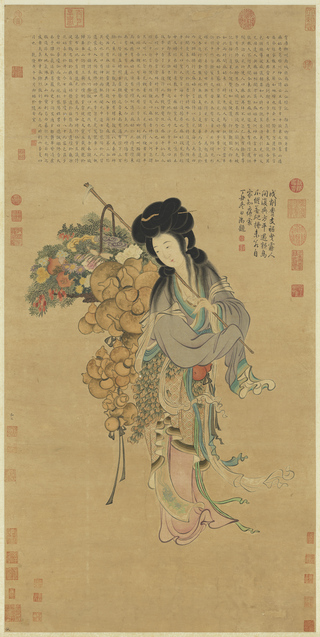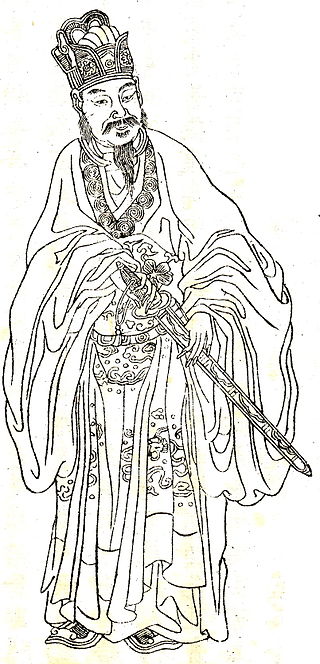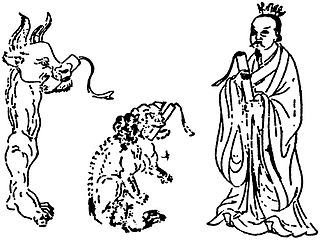
Liu Xiang,born Liu Gengsheng and bearing the courtesy name Zizheng,was a Chinese astronomer,historian,librarian,poet,politician,and writer of the Western Han dynasty. Among his polymathic scholarly specialties were history,literary bibliography,and astronomy. He is particularly well known for his bibliographic work in cataloging and editing the extensive imperial library.

The Biographies of Exemplary Women is a book compiled by the Han dynasty scholar Liu Xiang c. 18 BCE. It includes 125 biographical accounts of exemplary women in ancient China,taken from early Chinese histories including Chunqiu,Zuozhuan,and the Records of the Grand Historian. The book served as a standard Confucianist textbook for the moral education of women in traditional China for two millennia.

A xian is any manner of immortal,mythical being within the Taoist pantheon or Chinese folklore. Xian has often been translated into English as "immortal".

Magu is a legendary Taoist xian associated with the elixir of life,and a symbolic protector of women in Chinese mythology. Stories in Chinese literature describe Magu as a beautiful young woman with long birdlike fingernails,while early myths associate her with caves. Magu xian shou is a popular motif in Chinese art.

Consort Ban(c. 48 BCE –c. 2 BCE),or Ban Jieyu (Chinese:班婕妤;pinyin:Bān Jiéyú;Wade–Giles:Pan Chieh-yü),also known as Lady Ban (Pan),was a Chinese scholar and poet during the Western Han Dynasty (206 BCE –23 CE). Jieyu (婕妤) was a title for a third-rank palace lady,one rank below Zhaoyi and two ranks below the Empress.

Ge Xuan (164–244),courtesy name Xiaoxian,was a Chinese Taoist practitioner who lived during the eastern Han dynasty (25–220) and Three Kingdoms periods (220–280). He was the ancestor of Ge Hong and a resident of Danyang Commandery in the state of Eastern Wu during the Three Kingdoms period. Ge Xuan's paternal grandnephew,Ge Hong,gave him the title "Ge Xuan Gong",which translates as "Immortal Lord" or "Transcendent Duke". Ge Hong wrote extensively about his great-uncle,and said that some alchemical texts from his Baopuzi originally came from him. Ge Xuan was described by his descendant,Ge Chaofu,as the first recipient of the Lingbao sacred scriptures. He is remembered as a member of the Chinese Ge family and a prominent figure in the early development of Taoism.
The Shenxian Zhuan,sometimes given in translation as the Biographies of the Deities and Immortals,is a hagiography of immortals and description of Chinese gods,partially attributed to the Daoist scholar Ge Hong (283-343). In the history of Chinese literature,the Shenxian Zhuan followed the Liexian Zhuan.

Dongfang Shuo was a Han dynasty scholar-official,fangshi,author,and court jester to Emperor Wu. In Chinese mythology,Dongfang is considered a Daoist xian and the spirit of Venus who incarnated as a series of ancient ministers including Laozi. Dongfang Shuo is depicted in the Wu Shuang Pu by Jin Guliang.

Bigu is a Daoist fasting technique associated with achieving xian "transcendence;immortality". Grain avoidance is related to multifaceted Chinese cultural beliefs. For instance,bigu fasting was the common medical cure for expelling the sanshi 三尸"Three Corpses",the malevolent,grain-eating spirits that live in the human body,report their host's sins to heaven every 60 days,and carry out punishments of sickness and early death. Avoiding "grains" has been diversely interpreted to mean not eating particular foodstuffs,or not eating any food (inedia). In the historical context of traditional Chinese culture within which the concept of bigu developed,there was great symbolic importance connected with the five grains and their importance in sustaining human life,exemplified in various myths and legends from ancient China and throughout subsequent history. The concept of bigu developed in reaction to this tradition,and within the context of Daoist philosophy.
Wang Zhaoyuan was a Chinese female Confucian scholar and writer. Unusually for a woman scholar,she was distinguished by her philological scholarship,not poetry. Her main work consists of annotations to Liu Xiang's Biographies of Exemplary Women and the Lives of the Taoist Transcendents. She also shared Liu Xiang's interest in the interpretation of dreams.

The sanshi 三尸"Three Corpses" or sanchong 三蟲"Three Worms" are a Daoist physiological belief that demonic creatures live inside the human body,and they seek to hasten the death of their host. These three supernatural parasites allegedly enter the person at birth,and reside in the three dantian "energy centers",respectively located within the head,chest,and abdomen. After their human host dies,they are freed from the body and become malevolent ghosts.

Shijie,which has numerous translations such as liberation from the corpse and release by means of a corpse,is an esoteric Daoist technique for an adept to transform into a xian,typically using some bureaucratic ruse to evade the netherworld administrative system of life and death registration. The many varieties of shijie range from deceitful cases,such as a person feigning death by substituting the corpse of their recently deceased grandfather as their own,to supernatural cases,such as using a waidan alchemical sword to temporarily create a corpse-simulacrum,which enables one to escape and assume a new identity.
Li Shaojun was a fangshi,reputed xian,retainer of Emperor Wu of Han,and the earliest known Chinese alchemist. In the early history of Chinese waidan,Li is the only fangshi whose role is documented by both historical and alchemical (Baopuzi) sources.

Chu is a Daoist name used for various religious practices including communal chu (Kitchen) banquet rituals in Way of the Celestial Masters liturgy,the legendary xingchu associated with Daoist xian,and wuchu representing the wuzang in neidan meditation techniques.
Maming Sheng was a legendary Han dynasty Daoist alchemist and xian. He was a disciple of the transcendent and fangshi Anqi Sheng,who transmitted a secret waidan external alchemical scripture to him. Maming refined this elixir of immortality,but rather than take a full dose and immediately ascend to heaven,he only took half and lived for over 500 years as a secret dìxiān. Master Horse-neigh was a key figure in the Daoist Taiqing alchemical tradition. Furthermore,in Chinese Buddhism,Maming translates the name of the 2nd-century CE Indian Buddhist monk and polymath Aśvaghoṣa,so-called because when teaching the Dharma his words were intelligible even to animals.
Yin Changsheng was a famous Daoist xian from Xinye who lived during the Eastern Han dynasty. After serving more than ten years as a disciple of the transcendent Maming Sheng he received the secret Taiqing scriptures on Waidan. Several extant texts are ascribed to Yin Changsheng,such as the Jinbi wu xianglei can tong qi.
Bao Jing was a Daoist xian best known for having been a disciple of the transcendent master Yin Changsheng from whom he received the Taixuan Yin Shengfu,and for having transmitted a version of the Sanhuang wen to his disciple and son-in-law Ge Hong.
Lijia Dao was one of the oldest schools of religious Daoism and was popular throughout South China during the Six Dynasties (220-589). Lijia dao was founded by Li A. Since several Way of the Li Family practices resembled those of the Way of the Celestial Masters,such as healing with (fu) amulets and holding expensive chu "Kitchen" feasts,the sect is associated with the Southern Celestial Masters. Mainstream Daoist schools denounced the Way of the Li Family as heterodox,particularly for its charlatan healers who claimed extraordinary longevity. For instance,Li Tuo (李脫) or Li Babai and his disciple Li Hong (李弘) were executed in 324 for practicing sorcery and plotting rebellion.
Li A was a legendary Daoist xian and diviner who founded of the Way of the Li Family,which was one of the oldest schools of religious Daoism that was popular throughout South China during the Six Dynasties (220-589). Owing to his extraordinary lifespan,Li A's sobriquet was Babaisui gong,which resulted in confusion or conflation with several other transcendents,one named Li Babai,and the charlatan Li Tuo (李脫) who took the name Li Babai

Li Babai was the sobriquet of a Daoist elixir-master and xian who supposedly lived more than 800 years. The founder of the Way of the Li Family school of religious Daoism,Li A or Babaisui gong is associated with Li Babai. Two unscrupulous Daoist adepts surnamed Li exploited the pseudonym Li Babai. Li Kuan was a charlatan faith healer and who died from the plague,and Li Tuo (李脫) was a sorcerer who was executed in 324 for plotting a revolt against the Jin dynasty.












